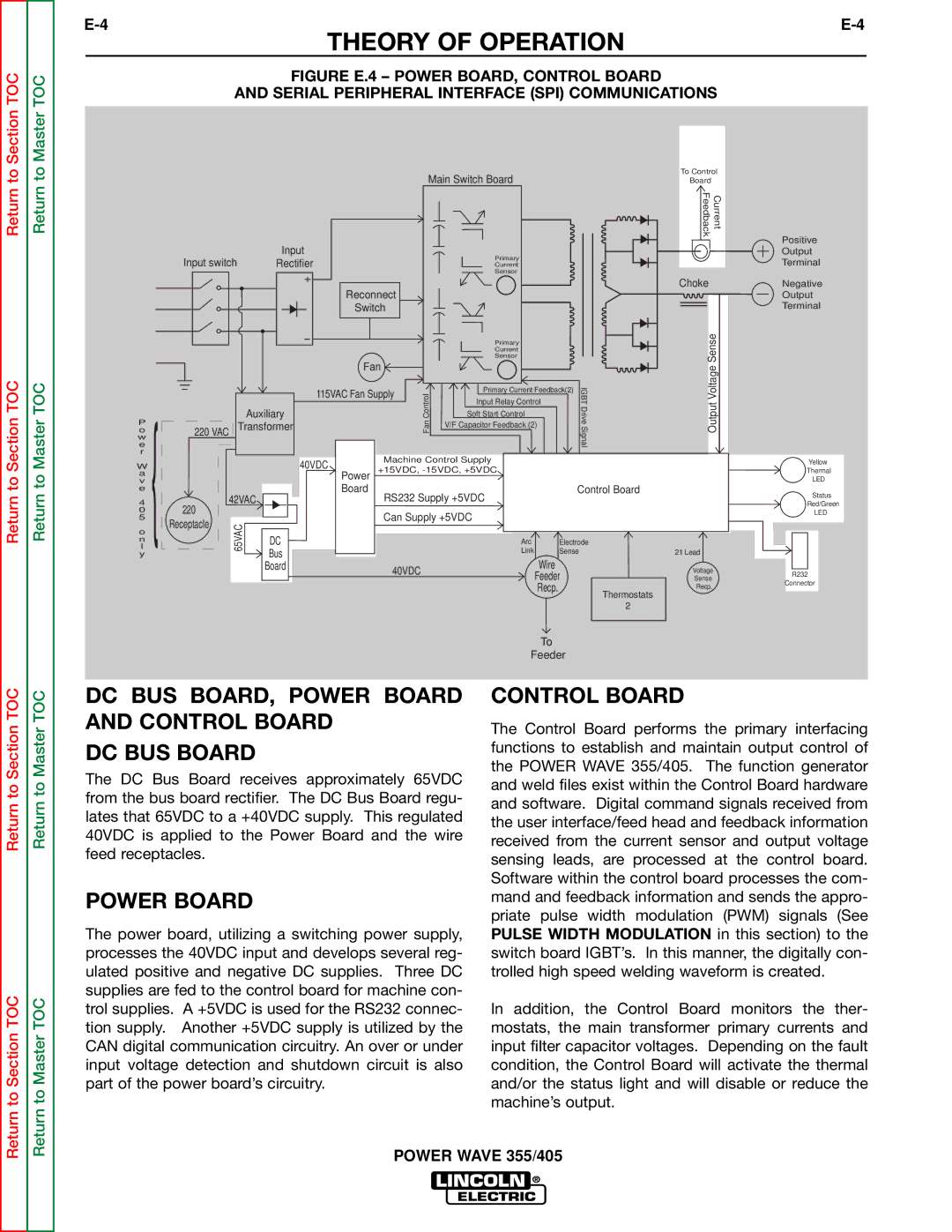
Section TOC
Master TOC
THEORY OF OPERATION
FIGURE E.4 – POWER BOARD, CONTROL BOARD
AND SERIAL PERIPHERAL INTERFACE (SPI) COMMUNICATIONS
Return to
Return to Master TOC
P
o { w
e
r
W
a
v
e
4
0
5
o n l y
Main Switch Board
Input
Input switch |
| Rectifier |
| Primary |
|
| |
|
| Current |
|
| |||
|
|
|
|
| Sensor |
|
|
|
|
| Reconnect |
|
|
| |
|
|
| Switch |
|
|
| |
|
|
|
|
| Primary |
|
|
|
|
|
|
| Current |
|
|
|
|
|
|
| Sensor |
|
|
|
|
| Fan |
|
| rive | |
|
|
|
|
|
|
| S |
|
|
| 115VAC Fan Supply | Primary Current Feedback(2) | IGBTDl | ||
|
|
| Soft Start Control |
| |||
|
|
| Auxiliary | Control |
| ||
|
|
|
|
| Input Relay Control |
|
|
220 VAC |
| Transformer | Fan | V/F Capacitor Feedback (2) |
| igna | |
|
|
|
| ||||
|
|
|
|
| |||
|
|
| 40VDC | Machine Control Supply |
|
| |
|
|
| +15VDC, |
|
| ||
|
|
| Power |
|
| ||
|
|
| Board | RS232 Supply +5VDC |
| Control Board | |
220 | 42VAC |
|
| ||||
|
|
| Can Supply +5VDC |
|
| ||
Receptacle | 65VAC |
|
|
| |||
|
|
|
|
| |||
| DC |
| Arc | Electrode | |||
|
|
| Bus |
| Link | Sense | |
|
|
| Board | 40VDC | Wire |
|
|
|
|
|
| Feeder |
| ||
|
|
|
|
|
| ||
|
|
|
|
| Recp. |
| Thermostats |
|
|
|
|
|
|
| |
|
|
|
|
|
|
| 2 |
|
|
|
|
| To |
|
|
|
|
|
|
| Feeder |
| |
To Control
Board
Feedback | Current |
Choke
SenseVoltage
Output
21 Lead
Voltage
Sense
Recp.
Positive
Output
Terminal
Negative
Output
Terminal
Yellow
Thermal
LED
Status
Red/Green
LED
R232
Connector
Return to Section TOC
Return to Section TOC
Return to Master TOC
Return to Master TOC
DC BUS BOARD, POWER BOARD AND CONTROL BOARD
DC BUS BOARD
The DC Bus Board receives approximately 65VDC from the bus board rectifier. The DC Bus Board regu- lates that 65VDC to a +40VDC supply. This regulated 40VDC is applied to the Power Board and the wire feed receptacles.
POWER BOARD
The power board, utilizing a switching power supply, processes the 40VDC input and develops several reg- ulated positive and negative DC supplies. Three DC supplies are fed to the control board for machine con- trol supplies. A +5VDC is used for the RS232 connec- tion supply. Another +5VDC supply is utilized by the CAN digital communication circuitry. An over or under input voltage detection and shutdown circuit is also part of the power board’s circuitry.
CONTROL BOARD
The Control Board performs the primary interfacing functions to establish and maintain output control of the POWER WAVE 355/405. The function generator and weld files exist within the Control Board hardware and software. Digital command signals received from the user interface/feed head and feedback information received from the current sensor and output voltage sensing leads, are processed at the control board. Software within the control board processes the com- mand and feedback information and sends the appro- priate pulse width modulation (PWM) signals (See PULSE WIDTH MODULATION in this section) to the switch board IGBT’s. In this manner, the digitally con- trolled high speed welding waveform is created.
In addition, the Control Board monitors the ther- mostats, the main transformer primary currents and input filter capacitor voltages. Depending on the fault condition, the Control Board will activate the thermal and/or the status light and will disable or reduce the machine’s output.
